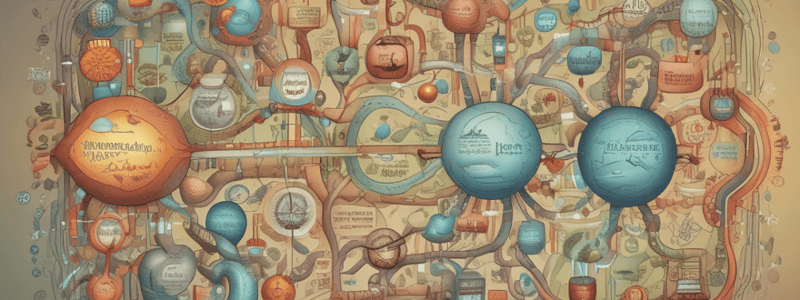Podcast
Questions and Answers
What is the primary function of Coenzyme A in cellular metabolism?
What is the primary function of Coenzyme A in cellular metabolism?
- To catalyze enzyme reactions
- To store energy from glucose and fatty acid oxidation (correct)
- To facilitate the breakdown of ATP
- To act as a prosthetic group
What is the energy yield from the breakdown of one mole of ATP?
What is the energy yield from the breakdown of one mole of ATP?
- Approximately 20 kJ
- Approximately 31 kJ (correct)
- Approximately 50 kJ
- Approximately 40 kJ
In which cellular compartment do the three stages of catabolism of sugars, fats, and amino acids occur?
In which cellular compartment do the three stages of catabolism of sugars, fats, and amino acids occur?
- Endoplasmic Reticulum
- Nucleus
- Mitochondria
- Cytosol (correct)
What is the term for the 'high energy' bond that links the acetyl group to Coenzyme A?
What is the term for the 'high energy' bond that links the acetyl group to Coenzyme A?
What is the role of cofactors in enzyme catalysis?
What is the role of cofactors in enzyme catalysis?
What is the term for the summary diagrams shown in biochemistry and cell biology textbooks?
What is the term for the summary diagrams shown in biochemistry and cell biology textbooks?
What is the correct definition of catabolism?
What is the correct definition of catabolism?
What is the term for the metal ions that are required for an enzyme's activity?
What is the term for the metal ions that are required for an enzyme's activity?
What is the function of Na+/K+ pumps in cellular metabolism?
What is the function of Na+/K+ pumps in cellular metabolism?
What is the byproduct of the reaction Glucose + ATP → Glucose-6-phosphate + ADP?
What is the byproduct of the reaction Glucose + ATP → Glucose-6-phosphate + ADP?
Which of the following nucleotides drives the synthesis of proteins?
Which of the following nucleotides drives the synthesis of proteins?
What is the net result of the glycolysis pathway?
What is the net result of the glycolysis pathway?
What is the net result of transferring 2 H atoms to NAD+?
What is the net result of transferring 2 H atoms to NAD+?
What prevents glucose 6-phosphate from diffusing back across the lipid membrane?
What prevents glucose 6-phosphate from diffusing back across the lipid membrane?
What is the product of aerobic metabolism of pyruvate?
What is the product of aerobic metabolism of pyruvate?
What is the characteristic of catabolic pathway names?
What is the characteristic of catabolic pathway names?
What is the role of NAD+ in metabolism?
What is the role of NAD+ in metabolism?
What is the co-factor that is oxidised in anaerobic metabolism?
What is the co-factor that is oxidised in anaerobic metabolism?
Why are metabolic pathways stepwise?
Why are metabolic pathways stepwise?
What is the composition of a hydrogen atom?
What is the composition of a hydrogen atom?
What is the result of transferring 1 H atom?
What is the result of transferring 1 H atom?
What is the number of carbon atoms in one molecule of glucose?
What is the number of carbon atoms in one molecule of glucose?
What is the role of activated carrier molecules in metabolism?
What is the role of activated carrier molecules in metabolism?
What is the function of ATP in metabolic control?
What is the function of ATP in metabolic control?
What is the significance of ATP in metabolic pathways?
What is the significance of ATP in metabolic pathways?
How many molecules of pyruvate are produced from one molecule of glucose in glycolysis?
How many molecules of pyruvate are produced from one molecule of glucose in glycolysis?
What is the result of hydrolysis of ATP?
What is the result of hydrolysis of ATP?
Why is the hydrolysis of ATP energetically favourable?
Why is the hydrolysis of ATP energetically favourable?
What is the significance of the specific proteins, enzymes, etc. in ATP?
What is the significance of the specific proteins, enzymes, etc. in ATP?
What is the characteristic of anabolic pathway names?
What is the characteristic of anabolic pathway names?
What is the importance of regulating specific enzymes in metabolic pathways?
What is the importance of regulating specific enzymes in metabolic pathways?
Why is ATP chemically stable at pH 6-9?
Why is ATP chemically stable at pH 6-9?
What is the final electron acceptor in the electron transport chain?
What is the final electron acceptor in the electron transport chain?
What is the purpose of the protein complexes in the electron transport chain?
What is the purpose of the protein complexes in the electron transport chain?
What is the result of the proton flow back through the membrane via ATP Synthase?
What is the result of the proton flow back through the membrane via ATP Synthase?
What happens to the carbon skeleton of amino acids that are surplus to requirements?
What happens to the carbon skeleton of amino acids that are surplus to requirements?
Where are the protein complexes of the electron transport chain embedded?
Where are the protein complexes of the electron transport chain embedded?
What is the result of the electrochemical gradient created by the electron transport chain?
What is the result of the electrochemical gradient created by the electron transport chain?
What is the role of NADH and FADH2 in the electron transport chain?
What is the role of NADH and FADH2 in the electron transport chain?
What is amino acid metabolism also known as?
What is amino acid metabolism also known as?
Flashcards are hidden until you start studying
Study Notes
Metabolism
- Metabolic pathways can be divided into two categories: catabolism (breakdown of molecules to release energy) and anabolism (synthesis of molecules to store energy)
- Catabolic pathway names end in '-lysis', while anabolic pathway names end in '-genesis'
Energy Release and Storage
- Energy released from catabolic pathways is stored in activated carrier molecules such as ATP, NADH, and FADH2
- ATP is the primary energy currency of the cell, with a hydrolysis energy of -31 to -50 kJ/mole
- ATP is chemically stable at pH 6-9 and has specific structural features recognized by proteins and enzymes
Regulation of Metabolic Pathways
- Metabolic pathways can be regulated by controlling specific enzymes
- Activating certain enzymes can speed up or slow down specific pathways
- Different 'forward' and 'reverse' pathways allow for separate regulation
Activated Carrier Molecules
- ATP is used in metabolic control, adding Pi to metabolic intermediates, and driving biosynthetic reactions
- UTP and GTP are also high-energy nucleotides used to drive specific biosynthetic reactions
- NAD+ is a high-energy electron carrier molecule that accepts H atoms and is used in catabolic pathways
Enzyme Cofactors
- Enzyme cofactors include ATP, coenzymes, activating ions, and prosthetic groups
- ATP acts as a high-energy cofactor for kinase enzymes, releasing energy upon breakdown
- Metal ions such as Mg2+ and Zn2+ are required for enzyme activity
Cellular Location of Metabolic Pathways
- Catabolism of sugars, fats, and amino acids occurs in three stages
- Glycolysis occurs in the cytosol, while the electron transport chain and citric acid cycle occur in the mitochondria
Glucose Metabolism
- Glucose is metabolized via the glycolysis pathway, resulting in the formation of pyruvate
- In aerobic metabolism, pyruvate is transported into the mitochondria and oxidized to acetyl-CoA
- In anaerobic metabolism, pyruvate is reduced to lactate, with simultaneous oxidation of NADH to NAD+
Electron Transport Chain
- The electron transport chain is a series of protein complexes embedded in the mitochondrial inner membrane
- Electrons are transported along the chain, releasing energy that is used to pump protons into the intermembrane space
- The resulting electrochemical gradient is used to drive the synthesis of ATP from ADP + Pi via ATP synthase
Amino Acid Metabolism
- Amino acid metabolism involves the removal of the nitrogen from the α-amino group and further metabolization of the carbon skeleton
- Amino acid metabolism is complex and varied, with different pathways for different amino acids
Studying That Suits You
Use AI to generate personalized quizzes and flashcards to suit your learning preferences.




